

Colombiareports. Kan alternatieve broodwinning Colombia’s drugsimperium ontmantelen? Verlichte gebouwen stijgen op in de schemering terwijl muziek speelt en mensen uitgelaten samentroepen.
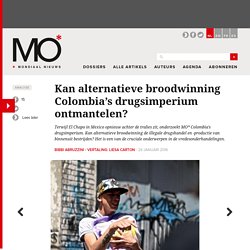
Het is een typische donderdagavond in de smalle straatjes met betegelde daken en kleurrijke huizen van La Candelaria in Bogotá. Op een openbaar basketbalplein staat Juan, met zijn lange haar, zwarte kleren en heavy metal look een joint te roken, een paar meter van een veiligheidsagent. ‘Ik ben niet iemand die geweld gebruikt’, zegt Juan, die vraagt om zijn echte naam om veiligheidsredenen weg te laten. Er steekt een lang mes uit Juans rugzak maar toch heeft hij niet de uitstraling van een geharde crimineel.
‘One love, hermana’, zegt hij en hij neemt een diepe teug van zijn sigaret. In 2014 overtrof de coca- en cocaïneproductie van Colombia die van Peru en Bolivia samen Juans job hangt af van mond-tot-mondreclame. Wereldwijde enquêtes plaatsen Colombianen boven aan de lijst als de gelukkigste mensen op aarde. Alternatieve broodwinning Eerst vrede Collateral damage. Understanding Colombia's armed conflict: The role of drugs. While not widely considered a cause, drug trafficking has played a mayor role in Colombia’s armed conflict as it has been the main source of income for the illegal armed groups involved in the violence.
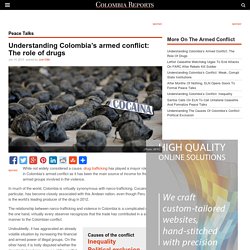
In much of the world, Colombia is virtually synonymous with narco-trafficking. Cocaine, in particular, has become closely associated with this Andean nation, even though Peru took over is the world’s leading producer of the drug in 2012. The relationship between narco-trafficking and violence in Colombia is a complicated one. On the one hand, virtually every observer recognizes that the trade has contributed in a significant manner to the Colombian conflict. Undoubtedly, it has aggravated an already volatile situation by increasing the financial and armed power of illegal groups.
Uribe and his followers tend to favor the former. The rise of narco-trafficking Weak institutions failed to adequately respond to the phenomenon. Time to Abandon Coca Fumigation in Colombia. By WOLA Senior Associate Adam Isacson Cultivation of coca, the plant used to make cocaine, has dropped steadily in Colombia since 2007.
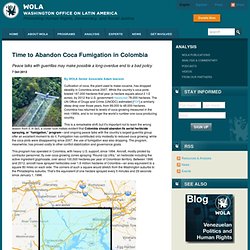
While the country’s coca plots totaled 167,000 hectares that year (a hectare equals about 2 1/2 acres), by 2012 the U.S. government measured 78,000 hectares. The UN Office of Drugs and Crime (UNODC) estimated [PDF] a similarly steep drop over those years, from 99,000 to 48,000 hectares. Colombia has returned to levels of coca-growing measured in the mid–1990s, and is no longer the world’s number one coca-producing country.
This is a remarkable shift, but it’s important not to learn the wrong lesson from it. The victims of Colombia aerial fumigation. The rural farmers who are negatively impacted by aerial fumigation in Colombia are one of the most overlooked groups affected by the continuing drug conflict in the South American nation.
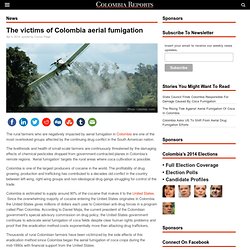
The livelihoods and health of small-scale farmers are continuously threatened by the damaging effects of chemical pesticides dropped from government-contracted planes in Colombia’s remote regions. ‘Aerial fumigation’ targets the rural areas where coca cultivation is possible. UN and U.S. Estimates for Cocaine Production Contradict Each Other. UN numbers suggest an increase in land under coca cultivation in Colombia, while "mysterious" U.S. numbers suggest a decrease Last Wednesday (July 25) the UN Office on Drugs and Crime issued a report with its latest findings about coca, the plant used to make cocaine, in Colombia.

The 112-page report explains that, from 2010 to 2011: Authorities in Awe of Drug Runners' Jungle-Built, Kevlar-Coated Supersubs. Photo: Christoph Morlinghaus The clatter of helicopter blades echoed across the jungles of northwestern Ecuador.

Antinarcotics commandos in three choppers peered at the mangroves below, scanning for any sign of activity. The police had received a tip that a gang of Colombian drug smugglers had set up a clandestine work site here, in a dense swamp 5 miles south of Colombia’s border. And whatever the traffickers were building, the tipster had warned, was truly enormous. For decades, Colombian drug runners have pursued their trade with diabolical ingenuity, staying a step ahead of authorities by coming up with one innovation after another.
Assembled in secret shipyards along the Pacific coast, they’ve been dubbed drug subs by the press, but they’re incapable of diving or maneuvering like real submarines. But several years ago, intelligence agencies began hearing that the cartels had made a technological breakthrough: They were constructing some kind of supersub in the jungle. Just the Facts - U.S. military aid to Latin America and the Caribbean - Waterfox. This post was written with CIP Cuba Intern, Ashley Badesch Despite Cuba’s absence from the recent OAS meeting, where antidrug policy in the Americas topped the agenda, Cuba collaborates with Latin American and Caribbean nations, and even the United States, on counternarcotics efforts.
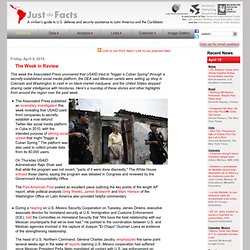
Cuba maintains formal agreements to fight narcotrafficking with at least 35 countries, including Mexico, Brazil, Chile, UK, Canada, Spain, Venezuela, Tanzania, Laos, and Jamaica. These accords allow Cuba to standardize counternarcotics operations and send real time alerts. Cocaine Production's Comeback - Waterfox.